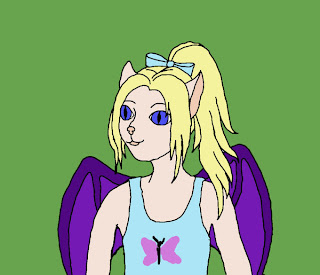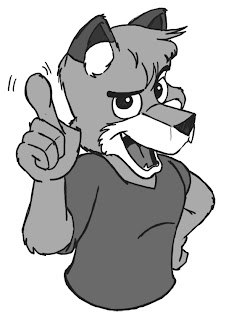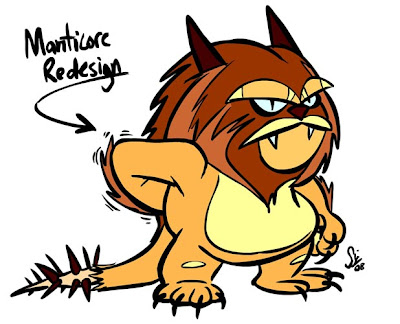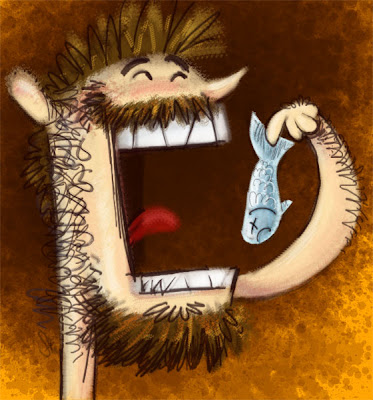After being in the program for about two years, and pulling my draftsmanship out of the world of embarrassing and into somewhat-acceptable, it was then that I could see just how much further I really had to go, and started to observe a general pattern of stepping stones for really great illustration. I say observation only, since not only is this just my own thoughts and opinions, but also if I knew exactly how to become great, I would probably be closer to getting there myself. At any rate, I like to think of these phases as three general stages:
Stage 1: Static, Flat and Constrained
 We've all been here before. This is the phase when the artist will be interested in illustration, and making valiant efforts to render the images in their mind, but lack the knowledge of anatomy, composition, silhouette, and directionality, let alone the ability to push the forms into 3D space. The result then, is work that generally comes out flat, constricted, and generally unappealing. Though, in the artists defense, they are making a valiant effort to improve. Or even if they aren't, they are at the very least putting in some good mileage towards improvement though experience.
We've all been here before. This is the phase when the artist will be interested in illustration, and making valiant efforts to render the images in their mind, but lack the knowledge of anatomy, composition, silhouette, and directionality, let alone the ability to push the forms into 3D space. The result then, is work that generally comes out flat, constricted, and generally unappealing. Though, in the artists defense, they are making a valiant effort to improve. Or even if they aren't, they are at the very least putting in some good mileage towards improvement though experience.Stage 2: Good Yet Boring
 At this phase, the artist has now become instructed in the ways of form, composition, anatomy, and their illustrations are now starting to resemble the shapes and images they are attempting to communicate. The problem here is, the illustrations in this phase are usually rather stale and end up looking the same. They may be well-constructed, but the artist is still roaming around within their comfort-zone, and are focusing mostly on the technical and academia aspects of constructing the image, rather than variation in style or experimentation in different ways to communicate visual ideas. In short, the illustrations become good, but not particularly interesting.
At this phase, the artist has now become instructed in the ways of form, composition, anatomy, and their illustrations are now starting to resemble the shapes and images they are attempting to communicate. The problem here is, the illustrations in this phase are usually rather stale and end up looking the same. They may be well-constructed, but the artist is still roaming around within their comfort-zone, and are focusing mostly on the technical and academia aspects of constructing the image, rather than variation in style or experimentation in different ways to communicate visual ideas. In short, the illustrations become good, but not particularly interesting.Stage 3: Dynamic and visually interesting
Finally at this phase, the artist has achieved a level of illustration prowess where issues like form, shape, and line are no longer technical concerns or problems for the artist. The focus at this level can now be purely on the communication, adapting whatever style or technique is necessary to properly render the image in a way that it will be most effective.
 Usually at this stage, the artist's work consists of a large variety of styles and experimentation, ranging from the realistic (above) to cartoony (below)...
Usually at this stage, the artist's work consists of a large variety of styles and experimentation, ranging from the realistic (above) to cartoony (below)... ...to flat graphic and highly stylized.
...to flat graphic and highly stylized. All of these stage-3 illustrations were done by the same artist. An extremely wide range of style but yet all with extreme confidence and deliberate line work, definitely a product of proper foundation and lots and lots of mileage/practice.
All of these stage-3 illustrations were done by the same artist. An extremely wide range of style but yet all with extreme confidence and deliberate line work, definitely a product of proper foundation and lots and lots of mileage/practice.I think it's also worth mentioning that not everyone needs to go through these 3 stages in order to be a successful illustrator or artist. It's possible to jump straight from stage 1 to stage 3, and develop an interesting style that doesn't necessarily rely on form or shape to communicate ideas. Of course, by doing this the artist risks not only limiting their style to only one possible look, but also risks that style being appealing to only a very select audience.
 Squidbillies is a perfect example of what this kind of style might look like. Of course, the Squidbillies animation team can actually draw incredibly beautifully and just happened to design this particular look for the series (which I personally find very unappealing), but exemplifies that it is possible to make that jump without being a master draftsman; even though it might be very limiting for that artist in the future.
Squidbillies is a perfect example of what this kind of style might look like. Of course, the Squidbillies animation team can actually draw incredibly beautifully and just happened to design this particular look for the series (which I personally find very unappealing), but exemplifies that it is possible to make that jump without being a master draftsman; even though it might be very limiting for that artist in the future.So, there are my idle thoughts on the journey towards becoming a great illustrator. I know I've certainly got a long way to go myself, and my next blog post will probably be yet another boring illustration from my amateur wrist, but I hope this article provided an interesting read, and in terms of how to get there, all I can do is quote my brilliant drawing instructor: "Draw! Draw, Draw, Draw!"
2 comments:
Hey, David!
This is Charles Choo, I met you a few days ago at Aaron's little meeting over at Psychobabble. I was trying to find your information and came across your blog. Just thought I'd say hello and that I enjoyed your analysis of illustration. haha. Hopefully i'll see you at the next Salon meeting. Peeace.
Charles.
Nice Post Badgerow! Yeah, very well put, I can't say that I disagree with anything in particular. Though I do have to say that the "IDEA" does govern whatever stage the artist is in much more than just a concern with technique or the ability to translate ones image in mind to paper, clay, screen, or whatever other medium. On the other hand, the development of ideas seems to follow a similar process to what you just mentioned. Either way, very interesting. I can definitely dig more posts like this...
Ré
Post a Comment